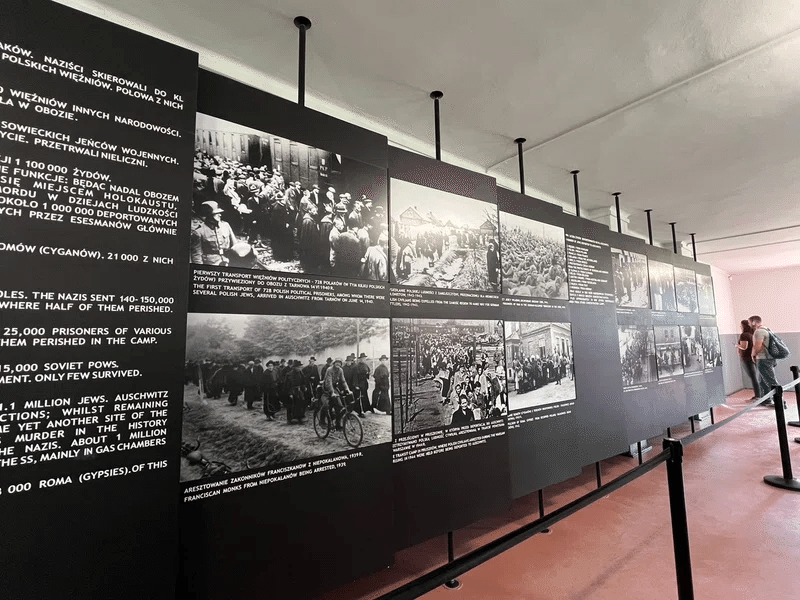
Auschwitz Travel Diary
Hello everyone, long time no see. It's been quite a while, then I'll start writing again.
In May, I went on a three-day, two-night trip to Poland and visited the Auschwitz Birkenau.
Before telling
To begin with, have you ever heard of the Auschwitz? Most of you probably know about it, but for those who do not, let me explain. In the past, there existed a political party in Germany called the Nazi Party. At the root of Nazi ideology was a hatred of democracy, communism, other peoples, and the exclusive superiority of the German race, with Jews being especially oppressed as an "inferior" race. In 1933, the Nazi Party seized power in Germany and concentration camps were built throughout the country. These camps housed opponents of Nazi ideology and criminal offenders. Auschwitz Birkenau is divided into several facilities, the first of which was built in June 1940. Then came the second half of World War II, when Poland was taken over by the Nazis and the Jews who lived there were sent to Auschwitz Birkenau.
In Auschwitz Birkenau
The Jews living in Poland were suffering from the high cost of living in small settlements due to the war. The Nazis thought that they could easily bring them to Auschwitz by tricking them into believing that they would be offered a new place to live. After all, they thought their current lives would be a little better, so they readily went to Auschwitz. They took a train to Auschwitz, but they were put in a freight car for livestock, and they were all made to stand inside the freight car. They were forced to stand there for several days without a toilet or food, and many of them collapsed.

Upon arrival at Auschwitz, the Jews were first divided into two groups. The first group was the group that forced the prisoners to work. The second group was the group that was murdered for being worthless. The murdered group consisted of children, the elderly, and the handicapped. They were lied to about taking showers and killed in poison gas chambers that were made to look just like bathrooms.
Those who survived, on the other hand, had their hair cut and their numbers tattooed on their bodies. They were then subjected to inhumane forced labor.
Breakfast was a mysterious black liquid that was said to be "coffee" (details are still unknown), lunch was a rotten vegetable soup, and dinner was soup, a slice of bread, and 3 grams of margarine. Since such food was not enough to fill one's stomach, many people died of starvation here.
What I saw in the museum
Nowadays, the Auschwitz-Birkenau Museum is located on the site of the Auschwitz, where the buildings as it was then is preserved.

Written on the gate is the German phrase "arbeit macht frei" (work and you will be free). If you look closely, you can see the letter B upside down. It is said that the prisoners who built this gate reversed the letter B in order to resist as much as possible.
After passing through the gate, you will see many buildings. There were a great number of prisoners living there. Each building had different exhibits, and there were so many that I will only introduce some of them.
Items confiscated from prisoners

Inside the camp, prisoners had all of their belongings confiscated. A small portion of what was confiscated at that time is on display here. In addition to shoes, there were glasses, bags, and prosthetic legs. And the most horrifying part was the hair of the prisoners on display. Photography was not allowed, so I cannot show you what it looked like, but it was quite graphic and disgusting. There were probably 10 times more than you can imagine. The reason why the hair was collected is that during the war, in order to increase supplies as much as possible, the hair was processed as thread and made into cloth. The Nazis considered the Jews to be like property, so they wanted to make the best use of them.
The rooms
In each building, rooms for various purposes remained.
The following is a description along with photos.

Prisoners were only allowed to go there twice a day.

The straw can be seen in the background.

Death Wall
The Wall of Death is the wall where the prisoners were shot to death.
This wall was located between the regular wings and was intended to instill fear by showing it to the other prisoners.

Poison gas chambers
At Auschwitz, children, pregnant women, the elderly, the disabled, the sick, and those who were unable to work were deemed unworthy and slaughtered in poison gas chambers. There are images of the poison gas chambers, and the walls are covered with nail marks left by people's suffering. Some people may be offended by this, so please be careful.

Incidentally, the poison used at this time was a substance called Zyklon B. There are empty cans of these spent cans in the museum.

Finally
Well, how was it? Of course there are many, many more exhibits here. Here at the Auschwitz Museum, there are audio guided tours in English, as well as guides and photo books written in English.
If you are interested, please visit there.
